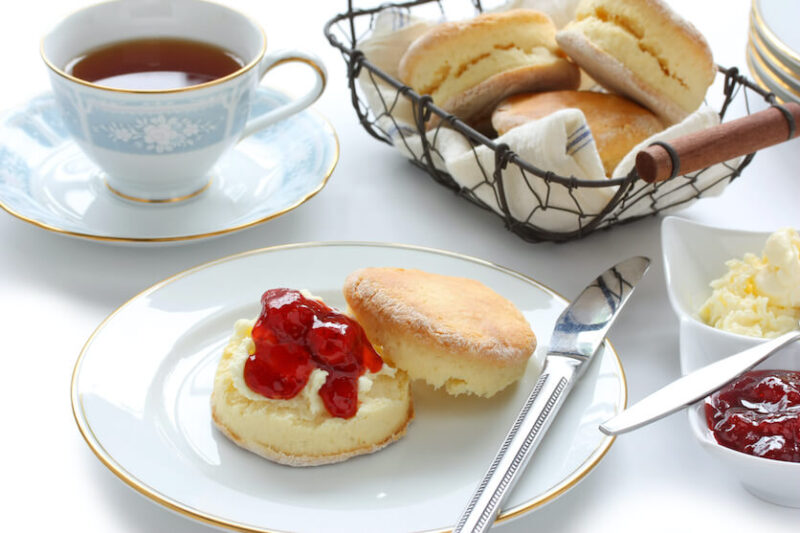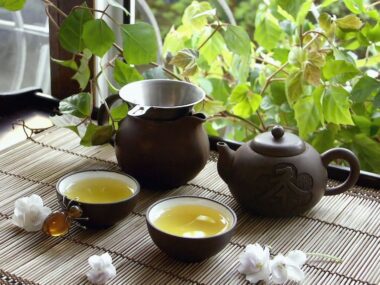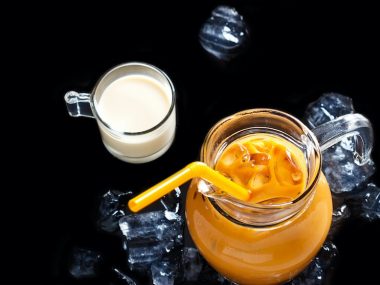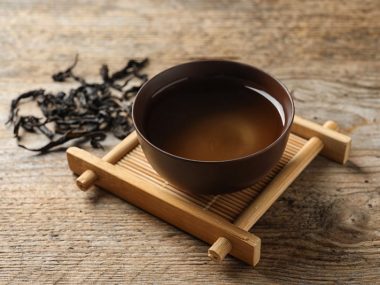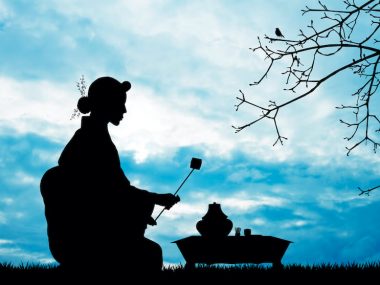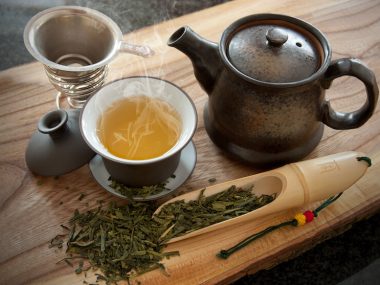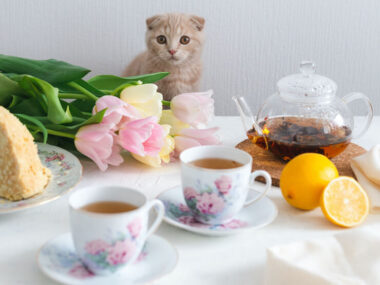Cream tea isn’t what you think it is, and it’s not a term referring to a tea with cream added. Cream tea is something you experience. Once you have it, you’ll find that you enjoy it so much, it becomes a part of your day!
Table of Contents
What Is Cream Tea?
If you have never been to the U.K. or had formal tea, then you are in for a surprise! Cream tea is the term used for tea time that includes scones and clotted cream. In essence, it’s the clotted cream and cups of tea that formed the “Cream Tea” description.
Cream tea came into existence back in the 1800s to serve for an afternoon consumption to quell growling stomachs until dinner time. Late evening dinner is part of the culture not only in the U.K. but throughout Europe. In contrast, Americans have dinner in the early evening, and as they are crawling into bed, most Europeans are just sitting down to enjoy dinner.
What Is The Difference Between Cream Tea and Afternoon Tea?
Unless you are from the U.K. or have lived there, trying to understand the various tea times the English have can be confusing. Most of us are somewhat familiar with high tea — and popular tea varieties served such as Earl Grey or Lady Grey — and its assumed association with an air of aristocracy. To add more confusion to the subject, the English refer to dinner as tea.
Various cultures eat meals at different times. The English have their own regime when they eat. A hearty English breakfast and breakfast tea are typically the morning faire. Lunch isn’t quite as significant in the U.K. as it is in the U.S. Instead, afternoon tea (cream tea) is lunch for the English.
The boundary between defining a mealtime is obscured among every culture. For example, “dinner” to those who live in the southern U.S. is lunch as it is for the English, and “supper” is dinner. “Afternoon snack” to Americans equates to “cream tea or afternoon tea” for the English.
Cream Tea (Also Known As Low Tea And Afternoon Tea)
Cream tea and afternoon tea are the same things. It’s a time set aside in the middle of the afternoon to have tea and something light to eat. Cream tea (afternoon tea) is the equivalent of lunchtime many of us know and follow.
Cream tea is what’s considered “low tea” not because it’s any lesser in social standing but because it’s an informal time to have tea and something to eat. It is served on “low” tables such as a coffee table or chairside table while watching the “tellie” (TV) or reading a favorite book.
High Tea
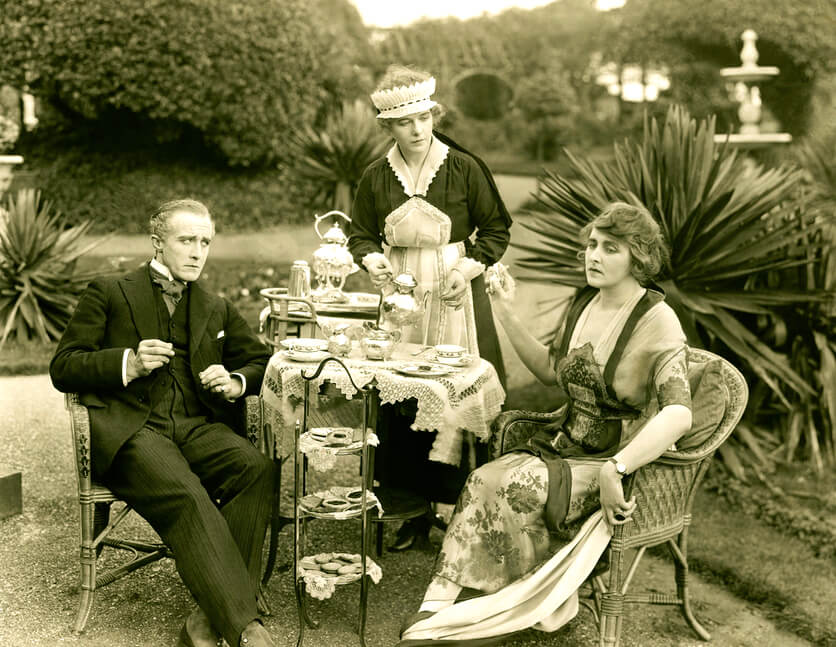
High tea is a time set aside in the late afternoon or early evening to have tea with a robust offering of substantial light foods. High tea gets its name because it is typically served at a higher table compared to a coffee table for afternoon/cream tea. A higher table is usually a dining table where people are seated.
A More “Formal” High Tea
Smaller intimate social gatherings such as a ladies group, a garden party, birthdays, baby showers, bridal showers, etc. sit down to “high” tea where they are served luxurious finger foods that include little sandwiches, pastries, cakes, scones, jams, clotted cream, and tea.
Most of us associate this type of high tea as “upper-crust,” where the finest china comes out and white-gloved servers roll out tiered platters of fancy little foods while preparing tea in a most traditional manner.
A Casual High Tea
The English refer to high tea as “tea,” which can translate to the evening meal. It can also refer to a “lunch-type” meal served in the afternoon. This is where many become confused because of the loosely-used term (“tea”) intended for a time to sit down and have something to eat.
What Is In A Cream Tea?
A traditional English cream tea is a black tea served with scones, jam, and clotted cream. Without the clotted cream, cream tea just wouldn’t be cream tea. Clotted cream is foreign to those who live outside the U.K.
Cream tea is much more simple and very casual compared to other tea times. English cream tea consists of freshly prepared hot black tea, a lightly sweetened biscuit-like confection (scone or Cornish split,) clotted cream, and jam.
In England, there are two different cream teas.
- One is served with Devon clotted cream and scones.
- The other consists of Cornish clotted cream, and a biscuit called a Cornish split.
Both may have clotted cream as the foundation of the cream tea. However, it’s how the English layer the clotted cream that sets them apart.
Cream tea provides a time where a light food and tea calms the growls of a hungry stomach. While many of us grab a bag of chips, cookies, or other unhealthy convenience foods, cream tea may undoubtedly be a better option. The intentional time of sitting down to enjoy tea and something to eat is peaceful and much better for digestion than eating something on the go.
Two English Styles Of Cream Tea
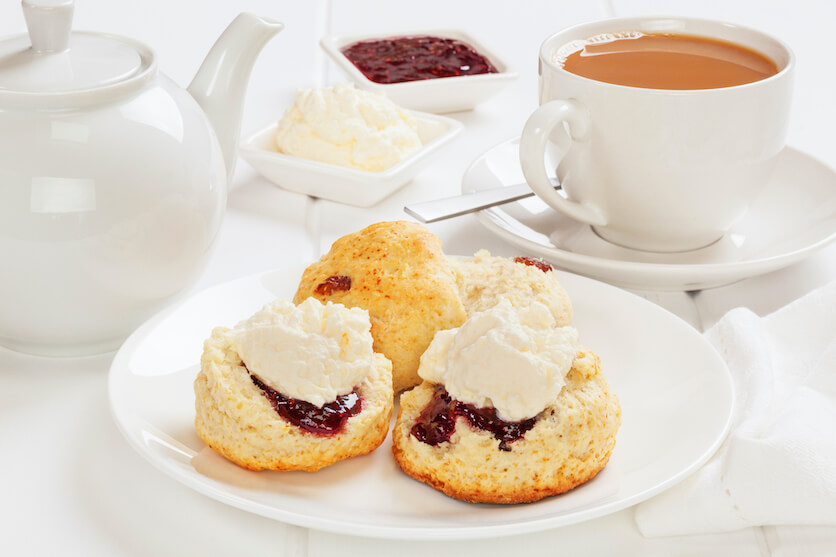
There is an ongoing dispute among two counties in England (Devon and Cornwall) as to who was the first to have created cream tea (clotted cream.) Devon is known to the English as “Devonshire,” so you may hear the two used interchangeably. Cornwall is referred to as “Cornish.”
| Devonshire-Style Cream Tea | Cornish-Style Cream Tea |
Consists of: Clotted cream made in Devon(shire) County of England Scones Jam Black tea | Consists of: Clotted cream made in Cornwall County of England Cornish-split biscuit Jam Black tea |
| Clotted cream is spread first on the scone and topped with jam. | Jam is spread first on a cornish split biscuit and topped with clotted cream. |
What Is Clotted Cream?
Clotted cream is a spreadable cream similar to butter but sweeter. Traditionally made (English) clotted cream is made from fresh milk (unpasteurized), which is placed into vats or pans where the milk rests, is slightly heated, and ends with a final rest. This final resting phase is where the magic happens.
Cream forms in the milk, and it’s this cream that is known as clotted cream. It’s not lumpy, as the name implies, but rather a thick custard consistency. The cream goes on to be refrigerated, and once it fully sets, a separating tool is used to peel away the cream and place it into containers. During the separation and chilling phases, a crust forms on top of the cream.
If it is commercially produced, the cream goes on to be packaged and shipped out. Some of the English prefer to make it themselves. Many local Cornwall and Devon dairy farms have self-help milk where the fresh (unpasteurized) milk is purchased and taken home to make clotted cream. Some of the local farmers also sell jars of the clotted cream to individuals.
Clotted cream shipped from England to other countries is required to be made with pasteurized milk. Unpasteurized milk is illegal in the U.S. because of food-borne pathogens that can develop. Besides, the clotted cream (made traditionally with unpasteurized milk) would never survive the long journey from England to other countries because of its short shelf life.
Cornish Clotted Cream Is Protected
Cornish clotted cream is considered highly unique in how it’s prepared (with the fresh milk of Cornwall county cows only.) A very well-known brand name of clotted cream produced in Cornwall has earned the right to fall under what’s called the “Protected Designation of Origin” by the European Union. This is a protective declaration that the clotted cream must be made in a certain region and by a certain method to be authentic.
Is Clotted Cream Illegal?
The unpasteurized milk prevents the traditional Devonshire and Cornish clotted creams from making it into other countries. The U.S., for example, requires by law that milk be pasteurized in various products (foreign or domestic) that contain milk. As such, very few commercial English clotted cream companies export it, and if they do, it must be made with pasteurized milk.
Pasteurization puts milk through an additional heating process that greatly affects the quality, texture, and taste of clotted cream. So, when visiting England, having clotted cream is definitely an indulgence because it will never be duplicatable here in the U.S. due to pasteurization.
What Is The Correct Way To Eat A Cream Tea?
In Cornwall county, England, a cream tea consists of black tea, a Cornish split biscuit, jam, and Cornish clotted cream. The jam is spread onto the Cornish split first and then topped with clotted cream. The ratio is typically 2:1 (2 dollops of clotted cream, 1 dollop of jam.) Many claim this is the best way to have cream tea because the clotted cream is more pronounced and doesn’t disappear behind the jam.
Likewise, if having cream tea Devonshire-style, cream tea will consist of black tea, a scone, jam, and Devonshire clotted cream. The clotted cream is spread onto the scone first and then topped with jam. The ratio is quite determined, but more jam goes on the scone than cream.
A Few Pointers On Cream Tea
The English have a rather unspoken way of how cream tea should be enjoyed (English etiquette.)
- Tea is always made with a good quality loose-leaf tea.
- The teapot, teacups, milk/sugar, clotted cream, jam, and scones are placed on a large serving tray and/or put on a coffee table.
- The person nearest the teapot is the one who pours the tea into the teacups, BUT only after milk is poured into the teacups of those who take their tea with milk.
- Teacups are always placed on a saucer with a spoon before handing it to someone.
How Much Caffeine Is In Cream Tea?
Because cream tea includes black tea, you can assuredly count on about 40-50 mg of caffeine in a six-ounce cup of tea. It might contain even more caffeine if it was brewed for a long time. The longer the brew, the higher the caffeine.
Most tea drinkers can safely enjoy about 4-6 cups of tea a day; however, if you have a medical condition or are taking medications, it’s always best to consult with your healthcare provider before consuming tea.
Is It Okay To Have Cream Tea Every Day?
Tea in and of itself is beneficial and fairly safe to have daily. However, certain medications or health conditions may restrict or limit the amount of tea consumed. Cream tea will pack on the pounds if enjoyed without moderation because of the added calories and fat from the clotted cream, scones/Cornish split biscuit, and jam.
The U.K. Food Standards Agency lists the nutritional breakdown of cream tea, and it may shock you to know this afternoon snack time is highly fattening.
Devonshire Clotted Cream
1 oz. serving
- Fat: 15 g
- Calories: 140
- Sugar: < 1 g
Cornish Clotted Cream
1 oz. serving
- Fat: 18 g
- Calories: 167
- Sugars: < 1 g
Scone (with jam and clotted cream)
- Calories: 756 – 900
- Sugar: up to 40 g
How To Make Cream Tea
Cream tea is easily made if living in the U.K. because of access to the “real deal” in clotted cream. However, no worries because you can still enjoy having cream tea with a few adjustments.
To get as close to a traditional cream tea as possible, it’s best to avoid substituting whipped cream in place of clotted cream. Butter just won’t get you there either. With a little planning, you can get the next best thing in clotted cream with a jar of Devon or Cornish clotted cream. This is the pasteurized form of clotted cream.
Ingredients
- A pot of brewed black tea made with loose-leaf tea
- Scones (purchased at a local market, ordered online, or homemade)
- 1 tablespoon of strawberry jam
- 1 tablespoon of Devonshire clotted cream
- Milk and sugar
Directions
- Add the desired amount of milk and sugar to your teacup.
- Pour the hot tea into the teacup.
- Prepare your scone (Devonshire-style with Jam up or Cornish-style with clotted cream up)
- Sit back and enjoy!
Cream Tea Is A Package Deal
Now you know cream tea is not the dairy you add to your tea but something that’s very English and filled with tradition. Cream tea is more than an afternoon snack; it’s a time of luxurious indulgence to re-energize and recharge to finish the day.
